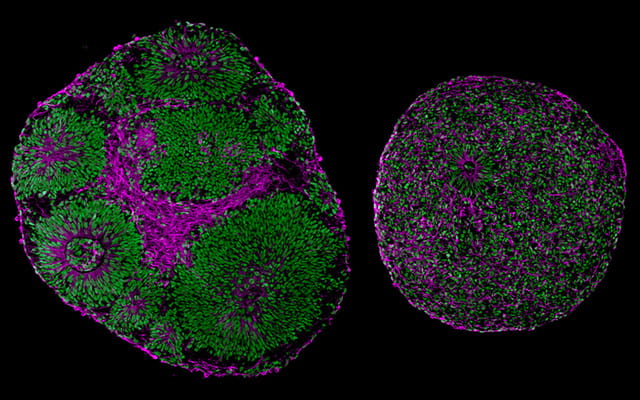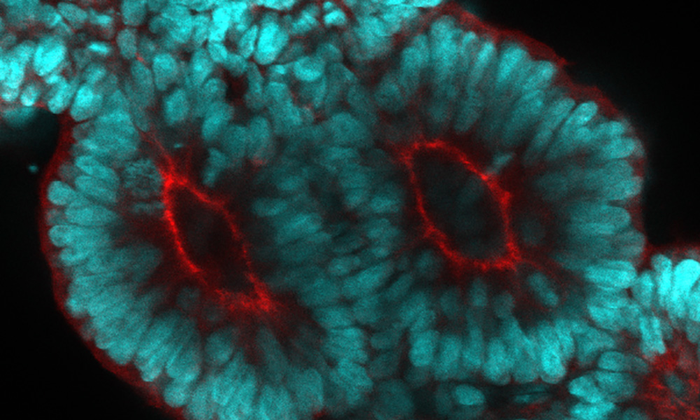UC San Diego scientists use lab-grown human brain tissue to identify neural abnormalities in Pitt-Hopkins Syndrome and show gene therapy tools can rescue neural structure and function.

news, journals and articles from all over the world.

UC San Diego scientists use lab-grown human brain tissue to identify neural abnormalities in Pitt-Hopkins Syndrome and show gene therapy tools can rescue neural structure and function.

The spinal column is the central supporting structure of the skeleton in all vertebrates.
Researchers led by George Sen, PhD, associate professor of dermatology and cellular and molecular medicine at UC San Diego School of Medicine, have identified the master regulator controlling the expression of genes regulating how the epidermis attaches to the underlying…
UC San Diego School of Medicine researchers will receive $6.4 million in National Institutes of Health grant funding to study how external signals and genetic variations influence the behavior of one cell type in particular: insulin-producing beta cells in the pancreas.
An experiment to study gravity at the quantum scale, insights into an antibiotic-building enzyme, and the backstory of an incredible new protein prediction algorithm are featured in this month’s roundup of science highlights.
Lab studies reveal protein HSP27’s role in blood vessel leakage, opening the possibility that therapeutically dialing its activity up or down might stabilize patients with sepsis.
The winners were nominated by colleagues and other leaders in their fields for making significant contributions to biochemistry and molecular biology and the training of emerging scientists.
Stem cell models derived from people with specific genomic variation recapitulate aspects of their autism spectrum disorder, providing a valuable model to study the condition and look for therapeutic interventions.
The journal Critical Review In Eukaryotic Gene Expression has just published an interesting article entitled: “Fungal And Bacterial Biodeterioration Of Outdoor Canvas Paintings: The Case Of The Cloisters Of Quito, Ecuador.”
UC San Diego researchers develop a method to grow hematopoietic stem cells in culture, with clinical implications for bone marrow transplants and aging research.
New research shows cells gather more data than once believed inside the thal-amus, a relay station of sensory and motor abilities in the brain. That could change how medicine treats schizophrenia, epilepsy and other brain disorders.
Alex Toker, professor of pathology at the Beth Israel Deaconess Medical Center and Harvard Medical School, will begin his term Oct. 1.
How do you study a group of organisms with over 300,000 species, dispersed across all seven continents, and with up to 50 times as much DNA content as the human genome? This is the question posed to biologists studying the…
Partners use AlphaFold, the AI system recognised last year as a solution to the protein structure prediction problem, to release more than 350,000 protein structure predictions including the entire human proteome to the scientific community
Replication of SARS-CoV-2, the virus responsible for COVID-19, depends on a series of interactions between viral proteins and different cellular partners such as nucleic acids (DNA or RNA). Characterizing these interactions is crucial to elucidate the process of viral replication…
Over the last few decades, neurodegenerative diseases became one of the top 10 global causes of death. Researchers worldwide are making a strong effort to understand neurodegenerative diseases pathogenesis, which is essential to develop efficient treatments against these incurable diseases.…
Known and yet unexpected: many active substances influence the cholesterol homeostasis and thereby possibly a SARS-CoV-2 infection
Researchers from Osaka University uncover a mechanism by which chromosomal rearrangements occur, with implications for novel cancer therapies
Bacteria on the sand on the ocean floor do not change between the seasons. Presumably, there is simply no room for change.
SARS-CoV-2 still poses major challenges to mankind. The frequent emergence of mutant forms makes the threat posed by the virus difficult to predict. The SARS-CoV-2 variant B.1.617 circulated in India and gave rise to the Delta variant, B.1.617.2, which is…
Although Enterococcus faecalis is usually an innocuous member of the bacterial community in the human gut, it can also cause several infections, including liver disorders. The bacteria produce cytolysins, which are molecules that destroy cells. In a new study, researchers…
Researchers at the RIKEN Center for Biosystems Dynamics Research (BDR) have succeeded in creating the first genetically engineered marsupial. This study, published in the scientific journal Current Biology , will contribute to deciphering the genetic background of unique characteristics observed…
CHAMPAIGN, Ill. — A new approach to treating breast cancer kills 95-100% of cancer cells in mouse models of human estrogen-receptor-positive breast cancers and their metastases in bone, brain, liver and lungs. The newly developed drug, called ErSO, quickly shrinks…
Researchers revealed new insights into how acute myeloid leukemia (AML) develops and progresses, according to a study published in Molecular Cell on July 20, 2021. They describe a mechanism by which AML cells regulate a cancer-related protein, mutant IDH2, to increase the buildup of blood cancer cells—a distinguishing characteristic of the disease.
Tokyo, Japan – While researchers have known for years that immunoglobulin A (IgA) is important for gut health, it has remained unclear exactly what role it plays in preventing infection and disease. But now, researchers from Japan have found that…
UCSF Cardiology researchers report no link between coffee consumption and arrhythmia
Researchers at Goethe University find small molecules as binding partners for genomic RNA of the coronavirus
Researchers revealed new insights into how acute myeloid leukemia (AML) develops and progresses, according to a study published in Molecular Cell on July 20, 2021. They describe a mechanism by which AML cells regulate a cancer-related protein, mutant IDH2, to…
Living organisms are often exposed to stress stimuli generated either by external or internal factors, and they need to respond accordingly. At a cellular level, stress usually triggers the activation of survival pathways that contribute to the recovery of cell…
Top-line results expected in the coming weeks
Tokyo, Japan – Chronic obstructive pulmonary disease (COPD) causes illness and death worldwide. It is characterized by destruction of the walls of tiny air sacs in the lungs, known as emphysema, and a decline in lung function. Little has been…
These findings suggest that for therapies to be effective, they must be targeted at both gene products
Errors in the metabolic processes of mitochondria are responsible for a variety of diseases such as Parkinson’s and Alzheimer’s. Scientists needed to find out just how the necessary building blocks are imported into the complex biochemical apparatus of these cell…
New technology reveals single cancer cells have different appetites for fatty acids
All cancers fall into just two categories, according to new research from scientists at Sinai Health, in findings that could provide a new strategy for treating the most aggressive and untreatable forms of the disease. In new research out this…
A scientific review has found evidence that a disruption in blood clotting and the first line immune system could be contributing factors in the development of psychosis. The article, a joint collaborative effort by researchers at RCSI University of Medicine…
New research from the RIKEN Center for Brain Science (CBS) in Japan shows that a deficit in histone methylation could lead to the development of autism spectrum disorders (ASD). A human variant of the SUV39H2 gene led researchers to examine…
Evolution is often portrayed as a tree, with new species branching off from existing lineages, never again to meet. The truth however is often much messier. In the case of adaptive radiation, in which species diversify rapidly to fill different…
Tokyo, Japan – Primary immunodeficiencies, such as severe combined immunodeficiency disease (SCID), occur when the immune system does not work properly, leading to increased susceptibility to various infections, autoimmunity, and cancers. Most of these are inherited and have an underlying…
UCSF outpatient study found limited effect of azithromycin on progression of disease
Targeting an RNA sequence in pathogenic bacteria could make them more sensitive to antibiotics
Researchers identify molecular cues that make developing neurons remodel their connections
A subset of fibroblasts located in small foci of tissue on the edges of extensive scarring produce a protein that protects against cell aging.
Cells, like many of us, fend off germs with cleaning products. Researchers have discovered that a molecule made throughout much of the body wipes out invading bacteria like a detergent attacking an oily stain. This killer cleaner, a protein known…
Results from a TGen-led international study suggest that SARS-CoV-2 takes advantage of genetic changes among patients with pre-existing lung diseases
While several biology techniques have undergone significant technical advances that have allowed their high-throughput implementation, assessing the resistance levels of plant varieties to microbial pathogens remains an arduous and time-consuming task. In response to this, Pujara and collaborators took advantage…
Scientists report that the alternative-splicing regulator NSrp70 influences immune T cell development
With its breathtaking views and striking stature, the Golden Gate bridge certainly deserves its title as one of the modern wonders of the world. Its elegant art deco style and iconic towers offer visitors a once-in-a-lifetime opportunity for astounding photographs.…
CAMBRIDGE July 13, 2021 – To date, solving structures of potential therapeutics using X-ray diffraction (XRD) has been an assumed, pivotal step in the drug development process. But a recent paper by a team of researchers led by NanoImaging Services…
Alejo Efeyan’s team at the CNIO has shown in animal models that blocking signals controlled by the RagC protein delays the onset of follicular lymphoma without side effects. This strategy may also be effective in the treatment of autoimmune diseases